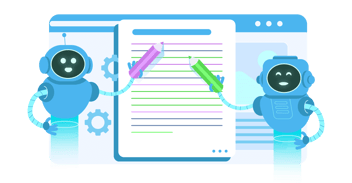The History of AI and Why It's Here to Stay
Artificial Intelligence, or AI, is no longer a buzzword but a driving force reshaping industries and our daily lives. But to understand the true power of AI, it's essential to understand its history. This journey, marked by both triumphs and challenges, has brought us to a point where AI is not just a possibility but a reality shaping our future.

The Seeds of Artificial Intelligence: 1950s-1960s
The dream of creating intelligent machines is as old as human thought itself. Philosophers like Aristotle pondered the nature of logic and reasoning, laying the groundwork for what would eventually become the field of AI. Myths and legends, such as the Golem of Prague, a mythical clay figure brought to life, further ignited imaginations about artificial beings. While rooted in fantasy, these early musings planted the seeds for the ambitious pursuit of creating intelligent machines.
The term "Artificial Intelligence" was formally coined in 1955 at a historic workshop at Dartmouth College. Led by John McCarthy, a group of pioneering scientists gathered to explore the possibility of creating machines that could "learn from experience and improve their performance." This marked the official birth of AI as a scientific discipline.
The subsequent decades were a rollercoaster of progress and setbacks. The 1950s saw the rise of symbolic AI, where computers manipulated symbols to mimic human thought processes. Alan Turing's groundbreaking Turing Test, proposed in 1950, became a benchmark for determining if a machine could exhibit intelligent behavior indistinguishable from a human. However, the limitations of symbolic AI soon became apparent, leading to the first "AI Winter" in the 1960s, a period of reduced funding and interest.
Despite these challenges, early successes emerged. ELIZA, a simple chatbot developed in the 1960s, demonstrated the potential of natural language processing. These initial breakthroughs, coupled with the enduring fascination with intelligent machines, kept the flame of AI research alive, setting the stage for future advancements.
It became clear that the path to artificial intelligence would be a long and winding one, marked by periods of rapid progress followed by inevitable plateaus. This cyclical nature would define the field for decades to come.
The Evolution of AI and the Rise of Machines: 1970s-2010s
The landscape of AI research underwent a transformative shift with the emergence of Machine Learning (ML) in the 1950s; unlike its rule-based predecessors, ML algorithms learned from data without explicit programming. This paradigm shift empowered AI systems to adapt and improve their performance over time.
ML found early applications in pattern recognition and decision-making. The 1960s saw the development of Perceptron, an early neural network model, laying the groundwork for future advancements. However, the limitations of early ML techniques led to another AI winter in the 1970s.
A resurgence occurred in the 1980s with the development of expert systems, which used rule-based knowledge to mimic human expertise. While successful in specific domains, expert systems lacked the adaptability of ML. This period also witnessed the introduction of backpropagation, an algorithm crucial for training neural networks efficiently.
The 1990s marked a turning point with the rise of support vector machines (SVMs) and decision trees, offering improved accuracy and efficiency. Additionally, the availability of larger datasets and increased computational power fueled ML research.
Building upon the foundation of ML, Deep Learning (DL) emerged in the 2000s. Inspired by the structure of the human brain, DL utilized artificial neural networks with multiple layers to process and learn from complex data. Breakthroughs in DL, coupled with the availability of massive datasets and increased computational resources, led to dramatic improvements in areas like image recognition, speech recognition, and natural language processing.
Landmark achievements include AlexNet, a convolutional neural network that won the ImageNet Large Scale Visual Recognition Challenge in 2012, marking a pivotal moment for DL. In the same decade, recurrent neural networks (RNNs) and long short-term memory (LSTM) networks gained prominence for processing sequential data, powering advancements in natural language processing and speech recognition.
Data has been a key catalyst for AI progress. The exponential growth of data, often referred to as Big Data, started in the late 20th century and created unprecedented opportunities for AI research. By analyzing vast datasets, AI systems could uncover intricate patterns, correlations, and insights that would be impossible for humans to detect manually. This data-driven approach has been instrumental in driving AI breakthroughs across industries.
The 2010s and beyond witnessed the democratization of AI with the development of user-friendly frameworks and libraries, making it accessible to a wider audience. AI applications expanded into various domains, from self-driving cars to medical diagnostics, showcasing the transformative potential of this technology.
AI Today
AI has rapidly integrated into the fabric of modern business, revolutionizing industries and redefining how we work.
Marketing
Marketing, especially data-driven marketing, has witnessed a dramatic transformation with AI at its helm. AI-powered marketing automation tools streamline repetitive tasks, freeing marketers to focus on strategic initiatives. Personalization has reached new heights as AI analyzes customer data to deliver tailored experiences, increasing engagement and conversions. Furthermore, AI-driven customer segmentation enables marketers to create highly targeted campaigns, maximizing ROI. A staggering 80% of marketers reported using AI in some capacity in 2023, underscoring its rapid adoption.
Finance
The finance industry has embraced AI to enhance efficiency, mitigate risks, and uncover new opportunities. AI-powered fraud detection systems can identify suspicious activities in real time, safeguarding financial institutions from losses. Risk assessment models leverage AI to evaluate creditworthiness and investment portfolios, enabling more informed decision-making. Algorithmic trading employs AI algorithms to execute trades at high speeds, capitalizing on market fluctuations. The global AI in finance market is projected to reach $267 billion by 2026, highlighting the immense potential of AI in this sector.
Healthcare
Healthcare is experiencing a renaissance thanks to AI. Medical image analysis powered by AI can detect diseases like cancer with unprecedented accuracy, aiding in early diagnosis and treatment. AI accelerates drug discovery by analyzing vast datasets to identify potential drug candidates, promising to revolutionize healthcare. Robotic surgery, guided by AI, offers enhanced precision and minimal invasiveness. A notable example is the use of AI in analyzing retinal scans to detect early signs of diabetic retinopathy, preventing vision loss for millions.
Consumer Usage and More
Consumer interactions are also profoundly impacted by AI. Social media platforms leverage AI for personalized content recommendations, targeted advertising, and sentiment analysis. AI-powered chatbots and virtual assistants, like Gemini or ChatGPT, offer human-like interactions, providing information, completing tasks, and even engaging in creative writing. AI-driven recommendation systems on streaming platforms analyze user preferences to suggest movies, TV shows, and music, enhancing user experience. As AI becomes more sophisticated, its role in shaping user interactions will continue to grow.
AI's influence extends far beyond these sectors. In transportation, self-driving cars powered by AI are poised to revolutionize mobility. Logistics benefits from AI-optimized route planning and inventory management, improving efficiency and reducing costs. AI-driven chatbots provide round-the-clock customer support in various industries, enhancing customer satisfaction. As AI continues to evolve, its applications will expand, reshaping the business landscape and our daily lives.
The Future of AI
The rapid advancement of AI has sparked both excitement and apprehension. It's essential to dispel common misconceptions about AI's role in society. While AI possesses remarkable capabilities, it is a tool designed to augment human intelligence, not replace it. Fears of AI taking over jobs or achieving consciousness, often fueled by science fiction, overshadow its potential benefits. AI excels at processing vast amounts of data and performing repetitive tasks, freeing humans to focus on creativity, problem-solving, and strategic thinking. The future lies in harnessing AI as a partner, collaborating to achieve outcomes beyond what either could accomplish alone.
Ethical considerations are paramount as AI continues to evolve. Bias in algorithms can perpetuate societal inequalities, and job displacement remains a concern. It's imperative to develop AI systems that are fair, transparent, and accountable. Robust ethical frameworks and regulations are necessary to mitigate risks and ensure that AI benefits all of humanity.
The road ahead for AI is filled with promise. Explainable AI (XAI) is emerging as a critical area of research, aiming to make AI systems more transparent and understandable. By demystifying AI's decision-making processes, XAI builds trust and fosters collaboration between humans and AI. Additionally, there's a growing emphasis on human-centered AI design, prioritizing user experience and ethical considerations.
We can envision a future where AI seamlessly integrates into our lives, enhancing our capabilities and quality of life. AI-powered innovations in healthcare, education, and environmental sustainability hold the potential to address global challenges. As we navigate this exciting era, we must approach AI development with a human-centric perspective, ensuring that technology serves as a force for good.
We will not be replaced by AI. What may of us might be replaced with is others who use AI quicker and more effectively than we do.
The future of AI is not about dominance or replacement but partnership and collaboration. By harnessing AI's potential responsibly and ethically, we can create a world where humans and AI thrive together, unlocking new possibilities and shaping a brighter future.
The AI Revolution is Here to Stay: Embrace It
The journey of artificial intelligence, from its philosophical origins to its current ubiquity, is a testament to human ingenuity. From the early days of symbolic logic to the sophisticated neural networks of today, AI has evolved at an astonishing pace. Its impact spans industries, transforming how we live, work, and interact.
At Aspiration Marketing, we understand the power of AI to drive business growth and success. With our expertise in leveraging AI for marketing, we can help you harness this technology to its full potential. Whether you need assistance with AI-powered marketing automation, data-driven insights, or personalized customer experiences, Aspiration Marketing can provide the strategic guidance and implementation support you need to thrive in the AI-driven landscape.
Are you ready to unlock the power of AI for your business?
This content is also available in:
- German: Die Geschichte der KI und warum sie sich durchsetzen wird
- Spanish: La historia de la IA y por qué está aquí para quedarse
- French: L'histoire de l'IA et les raisons de sa pérennité
- Italian: La storia dell'IA e il motivo per cui resterà in vita
- Romanian: Istoria inteligenței artificiale și de ce este aici pentru a rămâne
- Chinese: 人工智能的历史及其长盛不衰的原因

Joachim is a certified HubSpot trainer with over 13 years of experience in content marketing, strategy, website development, and SEO. He has implemented numerous large-scale, international growth marketing programs, including one with UiPath, which grew from a startup to a successful IPO on the NYSE. Joachim has special expertise in multilingual marketing and sales enablement projects, and he uses the latest AI technologies to help our clients.








Leave a Comment